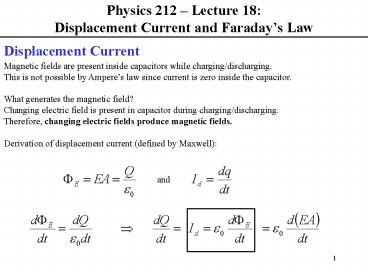Physics 212 Lecture 18: Displacement Current and Faradays Law - PowerPoint PPT Presentation
1 / 5
Title:
Physics 212 Lecture 18: Displacement Current and Faradays Law
Description:
This is not possible by Ampere's law since current is zero inside the capacitor. ... 30.5 Is Ampere's Law valid for all paths around a conductor? ... – PowerPoint PPT presentation
Number of Views:114
Avg rating:3.0/5.0
Title: Physics 212 Lecture 18: Displacement Current and Faradays Law
1
Physics 212 Lecture 18 Displacement Current
and Faradays Law
Displacement Current
Magnetic fields are present inside capacitors
while charging/discharging. This is not possible
by Amperes law since current is zero inside the
capacitor. What generates the magnetic
field? Changing electric field is present in
capacitor during charging/discharging. Therefore,
changing electric fields produce magnetic
fields. Derivation of displacement current
(defined by Maxwell)
and
2
Ampere-Maxwell Law
- - combines regular current with displacement
current
Faradays Law Changing magnetic fields inside a
loop of circuit produce a voltage in the loop
for N loops from definition of magnetic flux
3
Example Ch 30 380.2A flowing onto circular
capacitor with plate radii 10cm and 4mm apart.
Find (a) time rate of increase of E between
plates (b) B between plates but 5cm from center.
4
Example Ch 31 5Electromagnet produces uniform
B1.6T over 0.2m2 cross-sectional area. Place
another coil with N200 and R20 Ohms. Then,
turn off current to inner magnet over a period of
20ms. Find I induced in outer coil.
5
Questions for Groups
- 30.5 Is Amperes Law valid for all paths around
a conductor? Why is it not useful to calculate B
for all such paths? - 30.7 Is the magnetic field inside a toroid
uniform? - 30.9 A hollow copper tube carries current along
its length. What is B inside? Outside? - 30.10 Describe the similarities between Gausss
Law in electrostatics and Amperes Law in
magnetism. - 30.11 A conducting loop is in a B field along the
x-axis. How should you orient it for minimum
flux? Maximum flux? - 30.12 What new concept did Maxwells generalized
form of Amperes Law include?

